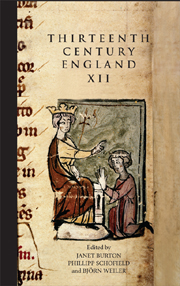Book contents
- Frontmatter
- Contents
- PREFACE
- LIST OF CONTRIBUTORS
- LIST OF ABBREVIATIONS
- The English and the Welsh in Fouke le Fitz Waryn
- Royal Piety in Thirteenth-century Scotland: The Religion and Religiosity of Alexander II (1214–49) and Alexander III (1249–86)
- The 1213 Pipe Roll and Exchequer Authority at the End of John's Reign
- The Public Debate during the Baronial Rebellion
- Richard of Cornwall and the Baronial Opposition in 1263
- Les liens personnels entre les cours de France et d'Angleterre sous le règne de Philippe III, 1270–85
- The Lay Opposition to Edward I in 1297: Its Composition and Character
- Peacekeepers and Lawbreakers in London, 1276–1321
- ‘The peace less kept’? The Origins, Revelations and Impact of Edward I's ‘Trailbaston’ Commissions of 1305–7
- Notes and Documents
The English and the Welsh in Fouke le Fitz Waryn
Published online by Cambridge University Press: 12 September 2012
- Frontmatter
- Contents
- PREFACE
- LIST OF CONTRIBUTORS
- LIST OF ABBREVIATIONS
- The English and the Welsh in Fouke le Fitz Waryn
- Royal Piety in Thirteenth-century Scotland: The Religion and Religiosity of Alexander II (1214–49) and Alexander III (1249–86)
- The 1213 Pipe Roll and Exchequer Authority at the End of John's Reign
- The Public Debate during the Baronial Rebellion
- Richard of Cornwall and the Baronial Opposition in 1263
- Les liens personnels entre les cours de France et d'Angleterre sous le règne de Philippe III, 1270–85
- The Lay Opposition to Edward I in 1297: Its Composition and Character
- Peacekeepers and Lawbreakers in London, 1276–1321
- ‘The peace less kept’? The Origins, Revelations and Impact of Edward I's ‘Trailbaston’ Commissions of 1305–7
- Notes and Documents
Summary
One important strand in historical writing on the peoples of the medieval British Isles has been the image that those peoples had of each other. A particular focus has been on the twelfth and early thirteenth centuries, when ecclesiastical authors such as Gerald of Wales propagated an overwhelmingly disparaging view of the Welsh, Irish and Scots. The ‘Celtic’ neighbours of the English, according to this view, still needed to be taught how to make the most of the economic potential of their countries; they led a largely pastoral existence; they were intensely warlike societies of freemen given to violent feuding and atrocities; they disregarded the directives of the reformed church; in short, to writers like Gerald of Wales, they wore ‘the face of the barbarian’. Once the stereotypes have been identified and treated as they deserve, there is much of great historical value to be gleaned from what Gerald of Wales wrote on the Welsh and the Irish. But it needs to be constantly borne in mind that elements of Gerald's image of the Welsh and Irish are paralleled in the writings of ecclesiastics throughout eleventh- and twelfth-century Europe, in Adam of Bremen's remarks on the Norwegians and the Icelanders, say, or in Helmold of Bosau's description of the Slavs.
The image of the barbarian did not simply disappear in thirteenth-century England. Several of the surviving copies of Gerald of Wales's ethnographic works date to that period.
- Type
- Chapter
- Information
- Thirteenth Century England XIIProceedings of the Gregynog Conference, 2007, pp. 1 - 12Publisher: Boydell & BrewerPrint publication year: 2009

